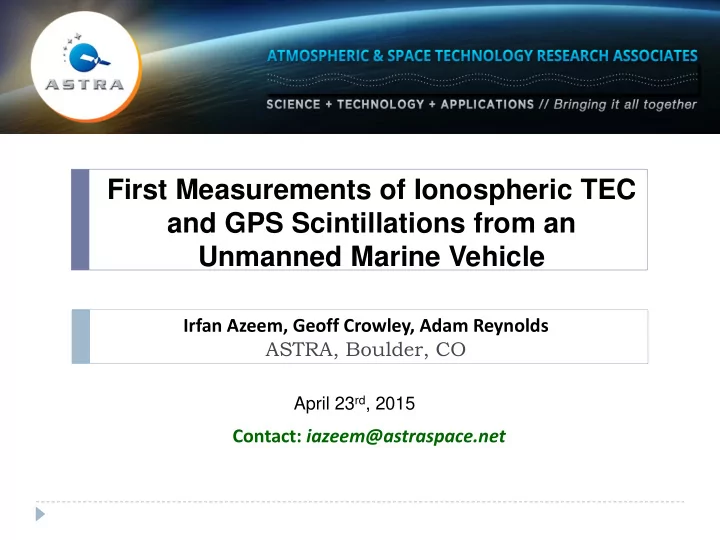

First Measurements of Ionospheric TEC and GPS Scintillations from an Unmanned Marine Vehicle Irfan Azeem, Geoff Crowley, Adam Reynolds ASTRA, Boulder, CO April 23 rd , 2015 Contact: iazeem@astraspace.net
Overview Agenda • Motivation • Introduction • GPS System Design • Results • Summary Ionospheric F Layer Ionospheric Irregularities 2(23)
Motivation ● Ionospheric variability can have a significant impact various RF systems, including communications, navigation, and surveillance operations . ● Lack of data from oceanic regions hinders our ability for global ionospheric specification and scintillation forecasting. ● Traditional ground-based ionospheric monitoring systems have not permitted coverage of large ocean areas or on-demand theater coverage. ● Technology Need Inexpensive, lightweight, low-power, and robust ionospheric monitoring system that can fill data gaps in coverage. 3(23)
GAMMA GPS Field Tests ● Successful field tests in Hawaii (2013, 2014) and Peru (2015) ● Fully-processed real-time ionospheric TEC and scintillation parameters 4(23)
GAMMA Software GPS Rx A software GPS Rx has been designed to provide continuous ionospheric TEC and scintillation from oceanic region The receiver has the following capabilities: Tracks GPS L1 and L2C signals even through deep fades Pseudorange-based TEC Carrier phase delta TEC Operates at low power (~4.5 W) Monitors and reports on its state of health GAMMA GPS showing the RF Front End (top), onboard computer Compensates for buoy motion on (middle), and the DSP (bottom). scintillation measurements Fully reconfigurable including data-rates, PLL and DLL bandwidths, etc. 5(23)
Motion Causes Artificial Sigma-Phi ● GPS measurements of ionospheric TEC and scintillation from moving platforms, such as ocean buoys, are extremely challenging ● Motion creates large phase variations that look like phase scintillation ● Creates a significant problem when attempting to measure real scintillation from a moving platform ● PLL bandwidth of standard GPS receivers too narrow to maintain satellite lock ● Current GPS phase scintillation techniques cannot discriminate between antenna motion and ionospheric irregularities Without Motion Correction Large Apparent Sigma-phi 6(23)
GPS Acquisition Strategy Set 52 Set 83 14 14 Number of PRNs tracked 12 12 10 10 Num PRNS 8 Num PRNS 8 6 6 4 4 Number of PRNs tracked 2 2 0 0 12:15 13:00 13:45 14:30 12:15 13:00 13:45 14:30 04/24/14 04/24/14 04/24/14 04/24/14 04/24/14 04/24/14 04/24/14 04/24/14 ● EML chip spacing = 0.1 ● EML chip spacing = 0.1 ● PLL bandwidth = 7.5 Hz ● PLL bandwidth = 40 Hz ● DLL bandwidth = 0.1 Hz ● DLL bandwidth = 0.05 Hz 7(23)
Removing Motion Effect from Sigma-Phi Solution: Use the integrated carrier phase to calculate antenna motion over the • scintillation window Use this information to remove the effect from the integrated carrier phase • Re-calculate sigma phi using corrected integrated carrier phase • Without Motion Correction With Motion Correction Large Apparent Sigma-phi True Sigma-phi 8(23)
Validation against Land-based Receivers With Motion Correction Without Motion Correction Large Apparent Sigma-phi True Sigma-phi MKEA ROTI Sigma_phi from nearby ASTRA Rx With Motion Correction Mauna Kea CORS GPS (25 miles from the Wave Glider) 9(23)
Validation in Peru January 21, 2015. Wave Glider deployed 11 miles off the coast of Lima. Scintillation event recorded by GAMMA from 0300 to 0400 UT on Jan 21 coincides well with the σ ϕ increase measured by the ground-based GAMMA receiver in Lima at the same time. 10(23)
VTEC from the Wave Glider (Hawaii) Land Based Measurement: Mauna Kea CORS GPS (25 miles from GAMMA GPS receiver on the ocean the Wave Glider) VTEC VTEC VTEC Augmented Dynamic Traditional Processing Receiver Processing Vertical TEC from the CORS receiver Vertical TEC from GAMMA on the Wave Glider. at Mauna Kea. 11(23)
VTEC in Peru January 21, 2015. GAMMA on Wave Glider in good agreement with GAMMA in Lima, Peru Ground Data Buoy Data 00 12 24UT 00 12 24UT 12(23)
Summary ● Existing GPS receivers are not able to provide ionospheric TEC and scintillation measurements from mobile platforms Requirements for different PLL and DLL bandwidths than usually used on static systems We have developed a software GPS receiver with the capability to dynamically change receiver bandwidths based on the sea state New algorithm to calculate phase scintillation and remove antenna motion 3 successful field tests (Hawaii and Peru) Multi-day tests supported by ground instrumentation Validated TEC and phase scintillations measurements from ground GPS receivers Upcoming field tests in May and June (Hawaii and Australia) 13(23)
Acknowledgement This work was supported by the Air Force Research Laboratory, Albuquerque, NM under an SBIR Phase II award to ASTRA. TPOC: Dr. Gordon Wilson 14(23)
Recommend
More recommend